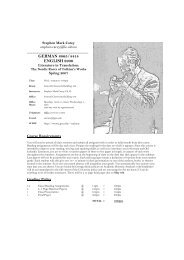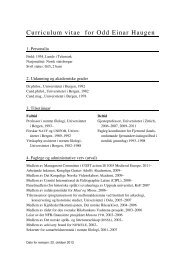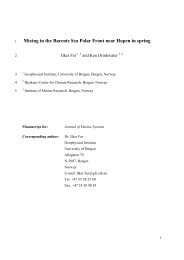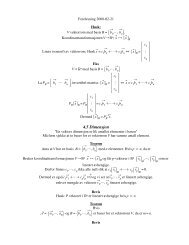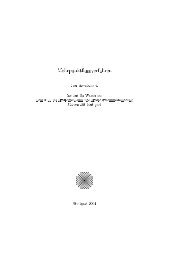UNIFOB - Uni Computing
UNIFOB - Uni Computing
UNIFOB - Uni Computing
You also want an ePaper? Increase the reach of your titles
YUMPU automatically turns print PDFs into web optimized ePapers that Google loves.
BCCS<br />
TECHNICAL REPORT SERIES<br />
Numerical studies of internal solitary wave<br />
trains generated at edges in the topography.<br />
Berntsen, J., Mathisen, J.-P. and Furnes, G.<br />
REPORT No. 21 April 13, 2007<br />
Report on Contract C06127 between NDP (Norwegian Deepwater<br />
Programme) and Fugro OCEANOR AS.<br />
(Subcontract to BCCS)<br />
<strong>UNIFOB</strong><br />
the <strong>Uni</strong>versity of Bergen research company<br />
BERGEN, NORWAY
BCCS Technical Report Series is available at http://www.bccs.no/publications/<br />
Requests for paper copies of this report can be sent to:<br />
Bergen Center for Computational Science, Høyteknologisenteret,<br />
Thormøhlensgate 55, N-5008 Bergen, Norway
1 Executive summary<br />
In this report some results from numerical studies of internal wave trains are given. The<br />
parameters of the experiments are chosen to be relevant for the Ormen Lange area. Many of<br />
the characteristics of the measured wave events are reproduced. However, the wave periods<br />
are still too short. In the model results the periods between consecutive waves in a wave<br />
train are typically 20 min whereas they are 45 min in the measurements we have focused<br />
on. A theoretical explanation for this discrepancy is given. Basically the periods between<br />
consecutive waves in a wave train depend on the distance from the generation point, and<br />
it would require more computer resources to follow the waves far enough to reproduce the<br />
45 min periods in numerical experiments. The amplitudes of the waves are reduced with<br />
distance frome the shelf edge. This means that closer to the generation point, the wave<br />
amplitudes and corresponding velocities may be significantly larger than those measured.
2 Description of the numerical experiments<br />
The σ-coordinate ocean model applied in the present studies is a two dimensional, (x,z),<br />
version of the model described in [Berntsen(2000)] where x and z are the horizontal and vertical<br />
Cartesian coordinates respectively. The model is available from www.math.uib.no/BOM/.<br />
The variables are discretized on a C-grid. In the vertical, the standard σ-transformation,<br />
σ = z−η<br />
H+η , where η is the surface elevation, and H the bottom depth, is applied. For advection<br />
of momentum and density a Total Variance Diminishing (TVD)-scheme with a<br />
superbee limiter described in [Yang and Przekwas(1992)] is applied in the present studies.<br />
The standard second order Princeton Ocean Model (POM) method is applied to estimate<br />
the internal pressure gradients ([Blumberg and Mellor(1987), Mellor(1996)]). The model<br />
is mode split with a method similar to the splitting described in<br />
[Berntsen et al.(1981)Berntsen, Kowalik, Sælid, and Sørli] and [Kowalik and Murty(1993)].<br />
Even if the model is two dimensional, flow in the across domain direction is allowed. However,<br />
there will be no across domain variability in this flow. The effects of the earths rotation<br />
are taken into account in the present studies and the Coriolis parameter is set to f =<br />
1.2 × 10−4 s−1 .<br />
It is known that internal waves may be formed behind topographic features in a stratified<br />
ocean, see for instance [Gill(1982), Baines(1995), Kundu and Cohen(2004), Thorpe(2005)].<br />
This is also studied recently in [Roth(2000)] and [Lamb(2007)]. In these papers it is shown<br />
that dispersive wave trains may be generated at a shelf edge in tidally forced systems. Inspired<br />
by the findings in [Roth(2000)] and [Lamb(2007)], a two-dimensional cross shelf<br />
model system has been set up with parameters of topography, forcing, and stratification<br />
that are relevant for the Ormen Lange area. The model area is 18000 m long. At x = 0 m a<br />
flow is forced into the system with a periodic forcing u = U0 sin(ω f t) where u is the velocity<br />
component in x direction, U0 the amplitude of the forced velocity. Generally the tidal<br />
signal is weak near the shelf edge in the Ormen Lange area. The wave trains were observed<br />
during periods with relatively strong winds. The wave trains are therefore assumed to be<br />
driven by inertial oscillations. The inertial frequency ω f is approximately 0.00013s−1 at<br />
our latitude, giving a period of 13.42 hours.<br />
In one set of experiments the focus is on solitary wave propagation outside the shelf,<br />
but generated at the shelf edge. In these experiments the depth profile H(x) in m, see Figure<br />
1, is specified according to<br />
<br />
−280 , x < 1000<br />
H(x) =<br />
120<br />
−400+<br />
, x > 1000.<br />
1+((x−1000)/W slope)∗∗4<br />
The slope width Wslope is taken to be 500 m in the present experiments. The studies of<br />
wave propagation off the shelf edge are performed with U0 equal to 0.3 m s −1 and 0.6 m s −1 .<br />
In another set of experiments the focus is on solitary wave propagation on the shelf.<br />
The depth profile in these studies H(x) in m, see Figure 11, is specified according to<br />
<br />
−280 , x > 1000<br />
H(x) =<br />
120<br />
−400+<br />
, x < 1000,<br />
1+((x−1000)/W slope)∗∗4<br />
where again the sill width is taken to be 500 m. The studies of wave propagation on the<br />
shelf are performed with U0 equal to 0.3 m s −1 and 0.4 m s −1 .<br />
Based on the measurements provided from this area an idealised initial stratification is<br />
assumed. The density at the surface is 1025.7 kg m 3 , the density at 50 m depth is 1027.3 kg m 3 ,<br />
and at 400 m depth the density is taken to be 1027.6 kg m 3 . Linear interpolation is used to<br />
compute the full density profile. With this density profile and theory about internal wave<br />
propagation the wave speed may be estimated to be in the range from 0.63 to 0.88 m s −1 .<br />
The model grid resolution is 25 m horizontally and 100 equidistant layers are used<br />
vertically. The model is run for two inertial periods. The results from the four experiments<br />
are summarised in the following sections.<br />
2
3 Solitary wave propagation off the shelf (U0 = 0.3 m s −1 )<br />
Below are some results for the case with solitary waves off the shelf, using a maximum<br />
inflow velocity of 0.3 m s −1 . A section of the density field after 11.74 hours and the depth<br />
profile is given in Figure 1. To get a better impression of the wave propagation, the density<br />
fields and two components of the velocity field at three consecutive times are given in<br />
Figures 2, 3, and 4. In these figures the focus is on the internal waves. At time equal to<br />
11.74 hours only one wave of suppression is seen in Figure 2. This wave is also seen after<br />
13.42 hours and 15.09 hours. However, at these later times a group of solitary waves is seen<br />
trailing the leading wave, In Figure 5 the u components at x = 5000 m and x = 15000 m are<br />
plotted as functions of time and depth, again with focus on the passing train of solitary<br />
waves.<br />
The speed of the front of the wave train in the period from 13.42 hours to 15.09 hours is<br />
approximately 0.56 m s −1 . The wave train changes form, and develops the typical solitary<br />
wave train characteristics as it propagates away from the edge. From Figure 5 the period<br />
between consecutive waves in the group may be estimated to be 24 minutes. It is also<br />
clearly seen that the first wave in the train is strongest, and the amplitudes of the waves<br />
behind are gradually reduced.<br />
depth [m]<br />
0<br />
−50<br />
−100<br />
−150<br />
−200<br />
−250<br />
−300<br />
−350<br />
25.8 25.9 25.8 25.9 26 25.8 25.9 26<br />
26<br />
26.1 26.1 26.1<br />
27.5<br />
26.7<br />
27.2<br />
26.2<br />
26.3<br />
26.5<br />
26.8<br />
26.6<br />
27.3<br />
27.4<br />
26.9<br />
26.5 26.3 26.2<br />
26.726.6<br />
26.9 26.8 27<br />
27.1 27.2 27.1<br />
27.3<br />
27.1<br />
26.4<br />
RHO (ci=0.1 )<br />
27<br />
27.5<br />
−400<br />
0 2000 4000 6000 8000 10000 12000 14000 16000 18000<br />
26.4<br />
distance [m]<br />
(a)<br />
26.3 26.2<br />
26.726.6<br />
26.5<br />
27.227.3<br />
27.427.4<br />
Figure 1: Topography and density field after 11.74 hours (7/8 of an inertial periods).<br />
3<br />
27.5<br />
26.8<br />
26.9<br />
26.4<br />
27
depth [m]<br />
depth [m]<br />
depth [m]<br />
0<br />
−10<br />
−20<br />
−30<br />
−40<br />
27.2<br />
−50<br />
−60<br />
−70<br />
−80<br />
−90<br />
26.8<br />
26.9<br />
RHO (ci=0.1 )<br />
−100<br />
4000 4200 4400 4600 4800 5000 5200 5400 5600 5800 6000<br />
0<br />
−10<br />
−20<br />
−30<br />
−40<br />
−50<br />
−60<br />
−70<br />
−80<br />
−90<br />
−30<br />
−20<br />
U (ci=10 cm/s )<br />
−30<br />
distance [m]<br />
(a)<br />
−20<br />
−100<br />
4000 4200 4400 4600 4800 5000 5200 5400 5600 5800 6000<br />
0<br />
−10<br />
−20<br />
−30<br />
−40<br />
−50<br />
−60<br />
−70<br />
−80<br />
−90<br />
0<br />
0<br />
W (ci=1 cm/s )<br />
distance [m]<br />
(b)<br />
2<br />
−100<br />
4000 4200 4400 4600 4800 5000 5200 5400 5600 5800 6000<br />
distance [m]<br />
(c)<br />
Figure 2: The train of solitary waves after 11.74 hours. The density field is given in a), the<br />
u component of the velocity field is given in b), and the vertical velocities in c).<br />
4<br />
0<br />
01<br />
−1<br />
0<br />
−20<br />
−1<br />
−1<br />
−30<br />
−20<br />
0
depth [m]<br />
depth [m]<br />
depth [m]<br />
0<br />
−10<br />
−20<br />
−30<br />
26.6<br />
−40<br />
−50<br />
−60<br />
−70<br />
−80<br />
−90<br />
26.9<br />
25.8<br />
25.9<br />
26<br />
RHO (ci=0.1 )<br />
26.5<br />
26.7<br />
26.326.4<br />
27.3<br />
−100<br />
2000 3000 4000 5000 6000 7000 8000<br />
0<br />
−10<br />
−20<br />
−30<br />
−40<br />
−50<br />
−60<br />
−70<br />
−80<br />
−90<br />
−10<br />
0<br />
0<br />
−10<br />
0<br />
0<br />
U (ci=10 cm/s )<br />
0<br />
0<br />
0<br />
0<br />
0<br />
0<br />
distance [m]<br />
(a)<br />
0<br />
0<br />
0<br />
26.8<br />
27 27.1<br />
−100<br />
2000 3000 4000 5000 6000 7000 8000<br />
0<br />
−10<br />
−20<br />
−30<br />
−40<br />
−50<br />
−60<br />
−70<br />
−80<br />
−90<br />
0<br />
0<br />
0<br />
0<br />
0<br />
0<br />
0<br />
0<br />
−10<br />
0<br />
0<br />
0 −1<br />
−1<br />
0 −1<br />
0<br />
1<br />
0<br />
2 1<br />
0<br />
W (ci=1 cm/s )<br />
0<br />
−1<br />
0<br />
0<br />
−1<br />
0<br />
0<br />
−2 −1<br />
−1<br />
0<br />
2<br />
−1<br />
−2<br />
−2<br />
0<br />
−1<br />
0<br />
0<br />
1<br />
−2<br />
0<br />
−1−1<br />
0<br />
−10<br />
distance [m]<br />
(b)<br />
00<br />
2<br />
−1<br />
−2<br />
0<br />
−2<br />
−1<br />
−2<br />
−100<br />
2000 3000 4000 5000 6000 7000 8000<br />
0<br />
0<br />
distance [m]<br />
(c)<br />
Figure 3: The train of solitary waves after 13.42 hours. The density field is given in a), the<br />
u component of the velocity field is given in b), and the vertical velocities in c).<br />
5<br />
−1<br />
−10<br />
0<br />
0<br />
0<br />
−20<br />
0<br />
0<br />
0<br />
27.2<br />
−10<br />
26.1<br />
26.2<br />
0<br />
0<br />
0<br />
0<br />
0<br />
0<br />
−1<br />
−1<br />
26.6<br />
−10<br />
−1
depth [m]<br />
depth [m]<br />
depth [m]<br />
0<br />
−10<br />
−20<br />
−30<br />
−40<br />
26.8<br />
−50<br />
−60<br />
−70<br />
−80<br />
−90<br />
RHO (ci=0.1 )<br />
25.9<br />
26<br />
26.3 26.4<br />
−100<br />
5000 6000 7000 8000 9000 10000 11000 12000<br />
0<br />
−10<br />
−20<br />
−30<br />
−40<br />
−50<br />
−60<br />
−70<br />
−80<br />
−90<br />
10<br />
10<br />
20<br />
U (ci=10 cm/s )<br />
26.1<br />
26.2<br />
distance [m]<br />
(a)<br />
25.8<br />
26.526.6 26.7<br />
27 27.1<br />
20<br />
20<br />
−100<br />
5000 6000 7000 8000 9000 10000 11000 12000<br />
0<br />
−10<br />
−20<br />
−30<br />
−40<br />
−50<br />
−60<br />
−70<br />
−80<br />
−90<br />
0<br />
0 0<br />
0<br />
0<br />
0 0<br />
0<br />
1<br />
0 0<br />
0<br />
0<br />
0<br />
1<br />
1<br />
1<br />
0<br />
0<br />
0<br />
0<br />
27.2<br />
distance [m]<br />
(b)<br />
0<br />
0<br />
0<br />
−100<br />
5000 6000 7000 8000 9000 10000 11000 12000<br />
0<br />
−1<br />
−1<br />
0 00 0<br />
0<br />
−1<br />
0<br />
−1<br />
−1<br />
−1<br />
W (ci=1 cm/s )<br />
0 00 0<br />
−1<br />
0<br />
−1<br />
0<br />
0<br />
−1<br />
0<br />
−1<br />
2<br />
0<br />
0<br />
−1<br />
−2<br />
0<br />
−2<br />
−1<br />
0<br />
−1<br />
1<br />
0<br />
2<br />
0<br />
−2<br />
−1−1<br />
0<br />
00<br />
−2<br />
−1<br />
0<br />
distance [m]<br />
(c)<br />
Figure 4: The train of solitary waves after 15.09 hours. The density field is given in a), the<br />
u component of the velocity field is given in b), and the vertical velocities in c).<br />
6<br />
−1<br />
−1<br />
−1<br />
0<br />
0<br />
26.9<br />
10<br />
26.8<br />
27.3<br />
1<br />
20<br />
0<br />
0<br />
0<br />
−1<br />
−1<br />
10<br />
−1<br />
0<br />
0
Depth [m]<br />
Depth [m]<br />
0<br />
−10<br />
−20<br />
−30<br />
−40<br />
−50<br />
−60<br />
−70<br />
−80<br />
−90<br />
−100<br />
11 11.5 12 12.5 13 13.5 14 14.5 15 15.5 16<br />
0<br />
−10<br />
−20<br />
−30<br />
−40<br />
−50<br />
−60<br />
−70<br />
−80<br />
−90<br />
−20<br />
−30<br />
−20<br />
U (ci=10 cm/s )<br />
20<br />
30<br />
U (ci=10 cm/s )<br />
−10−10<br />
−10<br />
−20<br />
20<br />
20<br />
−10<br />
0<br />
Time<br />
(a)<br />
40<br />
30<br />
−100<br />
16 16.5 17 17.5 18 18.5 19 19.5 20<br />
Time<br />
(b)<br />
Figure 5: Time development of the vertical profile of along section velocities at x = 5000 m<br />
(top) and x = 15000 m with focus on the waves. (The time is in hours.)<br />
7<br />
30<br />
30<br />
0<br />
0<br />
30<br />
10<br />
10<br />
20<br />
20<br />
20<br />
20<br />
20<br />
30<br />
10
4 Solitary wave propagation off the shelf (U0 = 0.6 m s −1 )<br />
Below are some results for the case with solitary waves off the shelf, using a maximum<br />
inflow velocity of 0.6 m s −1 . A section of the density field after 13.42 hours and the depth<br />
profile is given in Figure 6. The solitary wave trains generally become much stronger when<br />
the inflow velocity is increased. The density fields and two components of the velocity field<br />
at three consecutive times are given in Figures 7, 8, and 9. In these figures the focus is on<br />
the solitary wave train. In Figure 10 the u components at x = 5000 m and x = 15000 m are<br />
plotted.<br />
The speed of the front of the wave train in the period from 13.42 hour to 15.09 hours is<br />
approximately 0.57 m s −1 and in the period from 15.09 hours to 16.78 hours approximately<br />
1.09 m s −1 . The wave group also changes form, and develops the typical solitary wave train<br />
characteristics as it propagates away from the edge. From Figure 10 the period between<br />
consecutive waves in the group may be estimated to be 15 minutes. It is also clearly seen<br />
that the first wave in the group is strongest, and the amplitudes of the waves behind are<br />
gradually reduced. The speed in the firts wave exceeds 1.00 m s −1 .<br />
depth [m]<br />
0<br />
−50<br />
−100<br />
−150<br />
−200<br />
−250<br />
−300<br />
−350<br />
26<br />
26.7<br />
27<br />
25.8<br />
26.5<br />
25.9<br />
26.1<br />
27.1<br />
27.2<br />
26.6<br />
26.2 26.4<br />
26.3<br />
26.8<br />
26.9<br />
27.3<br />
26.8 26.7<br />
26.9<br />
27<br />
27.4<br />
25.8<br />
−400<br />
0 2000 4000 6000 8000 10000 12000 14000 16000 18000<br />
distance [m]<br />
(a)<br />
25.8<br />
27.3<br />
26<br />
25.9<br />
26 25.9<br />
26.6<br />
26.3<br />
27.3<br />
26.3<br />
27.2<br />
27.1<br />
26.1 26.1<br />
26.2<br />
26.4 26.4<br />
26.526.5<br />
27.5<br />
RHO (ci=0.1 )<br />
27.5<br />
27.4<br />
26.8 26.7<br />
26.9 27<br />
27.1<br />
27.2<br />
27.5<br />
26.6<br />
26.2<br />
26.7<br />
26.8<br />
26.9<br />
26.5<br />
25.8<br />
26.126.2<br />
26.6<br />
26<br />
26.4<br />
2727<br />
Figure 6: Topography and density field after 13.42 hours (one inertial period).<br />
8<br />
27.4<br />
27.5<br />
27.1<br />
27.2<br />
27.3<br />
27.5<br />
27.4<br />
26.3<br />
26.9<br />
26.8<br />
27.1<br />
27.2<br />
27.3<br />
27.5
depth [m]<br />
depth [m]<br />
depth [m]<br />
0<br />
−20<br />
−40<br />
−60<br />
−80<br />
−100<br />
−120<br />
−140<br />
−160<br />
−180<br />
26.7<br />
26.8<br />
26.9<br />
27.1<br />
27<br />
27.2<br />
27.3<br />
RHO (ci=0.1 )<br />
27.4<br />
26.5<br />
26.6<br />
26.1 26.2<br />
26<br />
25.8<br />
26.326.4<br />
26.8 26.7<br />
−200<br />
0 500 1000 1500 2000 2500 3000<br />
0<br />
−20<br />
−40<br />
−60<br />
−80<br />
−100<br />
−120<br />
−140<br />
−160<br />
−180<br />
0<br />
0<br />
0<br />
0<br />
0<br />
0<br />
0<br />
0<br />
0<br />
0<br />
0<br />
U (ci=10 cm/s )<br />
10<br />
20<br />
0<br />
0<br />
0<br />
10<br />
0<br />
26.9<br />
27<br />
distance [m]<br />
(a)<br />
0<br />
30<br />
20<br />
0<br />
−200<br />
0 500 1000 1500 2000 2500 3000<br />
0<br />
−20<br />
−40<br />
−60<br />
−80<br />
−100<br />
−120<br />
−140<br />
−160<br />
−180<br />
0<br />
0<br />
0<br />
0<br />
0<br />
0<br />
0<br />
0<br />
0<br />
0<br />
0<br />
0<br />
5<br />
−10<br />
0 0<br />
0<br />
−5<br />
−20<br />
0<br />
−5<br />
0<br />
5<br />
−10<br />
−10 −10<br />
10<br />
5<br />
W (ci=5 cm/s )<br />
0<br />
0<br />
−20<br />
0<br />
0<br />
0<br />
−10<br />
−5<br />
−30<br />
−20<br />
−40<br />
0<br />
−10<br />
0<br />
5<br />
10<br />
−10<br />
−20<br />
−30<br />
−10<br />
0<br />
−30<br />
−40<br />
−20<br />
0<br />
distance [m]<br />
(b)<br />
0<br />
27.1<br />
−60<br />
−50<br />
27.2<br />
−10<br />
0<br />
27.3<br />
0<br />
−40<br />
−30<br />
−20<br />
−200<br />
0 500 1000 1500 2000 2500 3000<br />
−5<br />
−15<br />
−10<br />
−5<br />
0<br />
0<br />
5<br />
15<br />
10<br />
25<br />
20<br />
0<br />
−5<br />
0<br />
−5<br />
−20<br />
−30<br />
−25<br />
−15<br />
−10<br />
−15<br />
−5<br />
distance [m]<br />
(c)<br />
Figure 7: The train of solitary waves after 13.42 hours. The density field is given in a), the<br />
u component of the velocity field is given in b), and the vertical velocities in c).<br />
−20<br />
9<br />
−15<br />
−25<br />
−10−10<br />
−5<br />
0<br />
0<br />
0<br />
0<br />
0<br />
0 0<br />
0<br />
0<br />
26.6<br />
−50
depth [m]<br />
depth [m]<br />
depth [m]<br />
0<br />
−20<br />
−40<br />
−60<br />
−80<br />
−100<br />
−120<br />
−140<br />
−160<br />
−180<br />
26.4<br />
25.8<br />
26.9<br />
26.1<br />
26.3<br />
26.2<br />
26.5<br />
26.6<br />
26.8<br />
−200<br />
2000 2500 3000 3500 4000 4500 5000 5500 6000 6500 7000<br />
0<br />
−20<br />
−40<br />
−60<br />
−80<br />
−100<br />
40<br />
−120<br />
−140<br />
−160<br />
−180<br />
30<br />
27<br />
RHO (ci=0.1 )<br />
27.4<br />
26.7<br />
27.3<br />
27.1<br />
26.9<br />
27.2<br />
distance [m]<br />
(a)<br />
−200<br />
2000 2500 3000 3500 4000 4500 5000 5500 6000 6500 7000<br />
0<br />
−20<br />
−40<br />
−60<br />
−80<br />
−100<br />
−120<br />
−140<br />
−160<br />
−180<br />
0<br />
0<br />
0<br />
30<br />
0<br />
0<br />
50<br />
U (ci=10 cm/s )<br />
0<br />
0<br />
0<br />
0<br />
0<br />
0<br />
0<br />
0<br />
0<br />
0<br />
W (ci=5 cm/s )<br />
00<br />
0<br />
0<br />
50<br />
0<br />
00<br />
0<br />
−5<br />
60<br />
20<br />
0<br />
0<br />
5<br />
−5<br />
−5<br />
−5<br />
−10<br />
30<br />
40<br />
60<br />
20<br />
50<br />
distance [m]<br />
(b)<br />
−200<br />
2000 2500 3000 3500 4000 4500 5000 5500 6000 6500 7000<br />
0<br />
0<br />
0<br />
0<br />
5<br />
0<br />
0<br />
20<br />
10<br />
40<br />
−10<br />
0<br />
5<br />
0<br />
27<br />
30<br />
40<br />
30<br />
10<br />
26.4<br />
50<br />
70<br />
60<br />
20<br />
distance [m]<br />
(c)<br />
10<br />
20<br />
10<br />
0<br />
0<br />
30<br />
−10<br />
0<br />
25<br />
−15−5<br />
−10 −15<br />
Figure 8: The train of solitary waves after 15.09 hours. The density field is given in a), the<br />
u component of the velocity field is given in b), and the vertical velocities in c).<br />
0<br />
−5<br />
−5<br />
−10<br />
−10<br />
10<br />
−20<br />
−15<br />
−5<br />
−15<br />
−10<br />
0<br />
−5<br />
0<br />
15<br />
0<br />
−10<br />
−20<br />
−25<br />
0<br />
−5<br />
−15<br />
−20<br />
25.9<br />
26<br />
26.3<br />
−20<br />
10<br />
20<br />
0<br />
−5<br />
−5<br />
10<br />
0 0<br />
10<br />
5<br />
5<br />
8070<br />
60<br />
40<br />
25.8<br />
26.2<br />
26.5<br />
27.1<br />
26.7<br />
26.1<br />
26.6<br />
26.8<br />
10<br />
0<br />
20<br />
20<br />
0<br />
30<br />
27.3<br />
20<br />
50<br />
0<br />
−25<br />
0<br />
20<br />
15<br />
25<br />
−5<br />
5<br />
−5<br />
−30<br />
−15<br />
−20<br />
−5<br />
−35<br />
−10<br />
30<br />
40<br />
−10<br />
0<br />
−20<br />
−25<br />
−10<br />
−15<br />
−10<br />
−5<br />
0<br />
0<br />
27.2<br />
27.4<br />
0<br />
26.9<br />
−10<br />
0<br />
0<br />
0<br />
0<br />
0<br />
27<br />
0<br />
0
depth [m]<br />
depth [m]<br />
depth [m]<br />
0<br />
−20<br />
−40<br />
−60<br />
−80<br />
−100<br />
−120<br />
−140<br />
−160<br />
−180<br />
25.8<br />
26<br />
26.1<br />
26.5<br />
26.2<br />
26.3<br />
26.4<br />
26.8<br />
26.6<br />
26.7<br />
0.8 0.85 0.9 0.95 1 1.05 1.1 1.15 1.2 1.25 1.3<br />
x 10 4<br />
−200<br />
distance [m]<br />
0<br />
−20<br />
−40<br />
−60<br />
−80<br />
−100<br />
−120<br />
−140<br />
−160<br />
−180<br />
27.4<br />
RHO (ci=0.1 )<br />
26.9<br />
27.1<br />
27<br />
27.2<br />
27.3<br />
(a)<br />
0.8 0.85 0.9 0.95 1 1.05 1.1 1.15 1.2 1.25 1.3<br />
x 10 4<br />
−200<br />
distance [m]<br />
0<br />
−20<br />
−40<br />
−60<br />
−80<br />
−100<br />
−120<br />
−140<br />
−160<br />
−180<br />
40<br />
0<br />
40<br />
0<br />
0<br />
40<br />
0<br />
0<br />
−5<br />
40<br />
70<br />
50<br />
U (ci=10 cm/s )<br />
0<br />
0<br />
5<br />
0<br />
0<br />
W (ci=5 cm/s )<br />
−5<br />
60<br />
40<br />
−5<br />
0<br />
0<br />
0<br />
70<br />
60<br />
10<br />
30<br />
80<br />
0<br />
5<br />
0<br />
5<br />
−5<br />
−10<br />
0<br />
50<br />
−5<br />
40<br />
−10<br />
−5<br />
40<br />
(b)<br />
0<br />
0<br />
0<br />
70<br />
0.8 0.85 0.9 0.95 1 1.05 1.1 1.15 1.2 1.25 1.3<br />
x 10 4<br />
−200<br />
distance [m]<br />
(c)<br />
Figure 9: The train of solitary waves after 16.78 hours. The density field is given in a), the<br />
u component of the velocity field is given in b), and the vertical velocities in c).<br />
5<br />
60<br />
10<br />
11<br />
100<br />
30<br />
90<br />
0<br />
80<br />
50<br />
−5<br />
0<br />
5<br />
−10<br />
0<br />
−5<br />
40<br />
−15<br />
−10<br />
0<br />
0<br />
−5<br />
0<br />
50<br />
10<br />
70<br />
40<br />
100<br />
30<br />
80<br />
26.1<br />
26.9 27<br />
27.1<br />
90<br />
0<br />
0<br />
5<br />
5<br />
−5<br />
−15<br />
0<br />
60<br />
−5<br />
−10<br />
−10<br />
25.9<br />
26.5<br />
−5<br />
−5<br />
0<br />
26<br />
27.2<br />
27.3<br />
40<br />
0<br />
5<br />
26.2<br />
50<br />
26.4<br />
26.8<br />
40<br />
26.3<br />
26.6<br />
26.7<br />
15<br />
27.4<br />
100<br />
80<br />
30<br />
110<br />
70<br />
90<br />
0<br />
10<br />
0<br />
5<br />
−5<br />
−10<br />
−5<br />
−15<br />
60<br />
−10<br />
−5<br />
−5<br />
25.8
Depth [m]<br />
Depth [m]<br />
0<br />
−20<br />
−40<br />
−60<br />
−80<br />
−100<br />
−120<br />
−140<br />
−160<br />
−180<br />
20<br />
10<br />
−200<br />
14 14.2 14.4 14.6 14.8 15 15.2 15.4 15.6 15.8 16<br />
0<br />
−20<br />
−40<br />
−60<br />
−80<br />
−100<br />
−120<br />
−140<br />
−160<br />
−180<br />
40<br />
−20<br />
−10<br />
U (ci=10 cm/s )<br />
50<br />
−30<br />
80<br />
100<br />
40<br />
30<br />
−40<br />
70<br />
110<br />
90<br />
60<br />
40<br />
80<br />
0<br />
30<br />
70<br />
100<br />
90<br />
U (ci=10 cm/s )<br />
60<br />
50<br />
70<br />
90<br />
80<br />
60<br />
30<br />
−30<br />
−20<br />
30<br />
70<br />
80<br />
60<br />
−10<br />
90<br />
−10<br />
30<br />
0<br />
Time<br />
(a)<br />
50<br />
30<br />
20<br />
30<br />
70<br />
40 40<br />
10<br />
20<br />
10<br />
0<br />
20<br />
50<br />
60<br />
30<br />
0<br />
40<br />
40<br />
−200<br />
17 17.5 18 18.5 19 19.5 20<br />
20<br />
Time<br />
(b)<br />
Figure 10: Time development of the vertical profile of along section velocities at x = 5000 m<br />
(top) and x = 15000 m with focus on the waves.<br />
12<br />
50<br />
70<br />
80<br />
20<br />
60<br />
60<br />
80<br />
50<br />
30<br />
40<br />
7060<br />
10<br />
20 20<br />
30<br />
20<br />
40<br />
20<br />
40<br />
80<br />
50<br />
7060<br />
10<br />
50<br />
20<br />
40<br />
30<br />
50<br />
60<br />
70<br />
30<br />
40<br />
50<br />
70<br />
30<br />
0<br />
0
5 Solitary wave propagation on the shelf (U0 = 0.3 m s −1 )<br />
Below are some results for the case with solitary waves on the shelf, using a maximum<br />
inflow velocity of 0.3 m s −1 . A section of the density field after 11.74 hours and the depth<br />
profile is given in Figure 11. The density fields and two components of the velocity field at<br />
three consecutive times are given in Figures 12, 13, and 14. In Figure 15 the u components<br />
at x = 10000 m and x = 15000 m are plotted.<br />
The speed of the front of the wave train in the period from 11.74 hour to 13.42 hours is<br />
approximately 0.53 m s −1 and in the period from 13.42 hours to 15.09 hours approximately<br />
0.68 m s −1 . The wave group also changes form, and develops the typical solitary wave train<br />
characteristics as it propagates away from the edge. From Figure 15 the period between<br />
consecutive waves in the group may be estimated to be 24 minutes.<br />
depth [m]<br />
0<br />
−50<br />
−100<br />
−150<br />
−200<br />
−250<br />
−300<br />
−350<br />
27.2<br />
27.3<br />
27.4<br />
26.2<br />
26.3<br />
26<br />
25.9<br />
26.5 26.7<br />
27.127.1<br />
26<br />
25.8 25.9 25.8 25.9 25.8<br />
26.3 26.1<br />
26.5<br />
26.7<br />
26.7<br />
26.9<br />
26.8<br />
27.1 26.9<br />
26.9<br />
27.227.2<br />
27.3<br />
26.126.1<br />
26.6<br />
27.5<br />
26.4<br />
26.8<br />
27.4<br />
27.3<br />
27<br />
RHO (ci=0.1 )<br />
27.5<br />
26.2<br />
26.3<br />
26.5<br />
26.6<br />
−400<br />
0 2000 4000 6000 8000 10000 12000 14000 16000 18000<br />
distance [m]<br />
(a)<br />
26.2<br />
26<br />
26.6<br />
26.4 26.4<br />
Figure 11: Topography and density field after 11.74 hours (7/8 of an inertial periods).<br />
13<br />
27.4<br />
26.8 27<br />
27.3<br />
27.5<br />
27.4<br />
27
depth [m]<br />
depth [m]<br />
depth [m]<br />
0<br />
−10<br />
−20<br />
−30<br />
−40<br />
−50<br />
−60<br />
−70<br />
−80<br />
−90<br />
RHO (ci=0.1 )<br />
27<br />
27.1<br />
−100<br />
6000 6200 6400 6600 6800 7000 7200 7400 7600 7800 8000<br />
0<br />
−10<br />
−20<br />
−30<br />
−40<br />
−50<br />
−60<br />
−70<br />
−80<br />
−90<br />
−10<br />
distance [m]<br />
(a)<br />
−100<br />
6000 6200 6400 6600 6800 7000 7200 7400 7600 7800 8000<br />
0<br />
−10<br />
−20<br />
−30<br />
−40<br />
−50<br />
−60<br />
−70<br />
−80<br />
−90<br />
−30<br />
0<br />
0<br />
0<br />
−20<br />
U (ci=10 cm/s )<br />
0<br />
0<br />
0<br />
00<br />
U (ci=2 cm/s )<br />
−10<br />
0<br />
0<br />
0<br />
−30<br />
−20<br />
0<br />
0<br />
−10<br />
distance [m]<br />
(b)<br />
2<br />
0<br />
−100<br />
6000 6200 6400 6600 6800 7000 7200 7400 7600 7800 8000<br />
0<br />
distance [m]<br />
(c)<br />
Figure 12: The train of solitary waves after 11.74 hours. The density field is given in a), the<br />
u component of the velocity field is given in b), and the vertical velocities in c).<br />
0<br />
14<br />
0<br />
−2<br />
0<br />
−2<br />
−30<br />
26.3<br />
−2<br />
25.9<br />
−30<br />
0<br />
27.2<br />
26.5<br />
0<br />
26.4<br />
0
depth [m]<br />
depth [m]<br />
depth [m]<br />
0<br />
−10<br />
−20<br />
−30<br />
−40<br />
−50<br />
−60<br />
−70<br />
−80<br />
−90<br />
26.8<br />
26.1<br />
26.2<br />
RHO (ci=0.1 )<br />
26.6<br />
26.7<br />
25.825.9<br />
27.2<br />
−100<br />
8000 8500 9000 9500 10000 10500 11000<br />
0<br />
−10<br />
−20<br />
−30<br />
−40<br />
−50<br />
−60<br />
−70<br />
−80<br />
−90<br />
0<br />
U (ci=10 cm/s )<br />
distance [m]<br />
(a)<br />
0<br />
0<br />
26.5<br />
27.1<br />
26.927<br />
−100<br />
8000 8500 9000 9500 10000 10500 11000<br />
0<br />
−10<br />
−20<br />
−30<br />
−40<br />
−50<br />
−60<br />
−70<br />
−80<br />
−90<br />
0 0<br />
0<br />
0<br />
0<br />
0<br />
0<br />
0<br />
0<br />
0<br />
U (ci=2 cm/s )<br />
−2<br />
0<br />
0<br />
0<br />
distance [m]<br />
(b)<br />
0<br />
0<br />
0<br />
−2<br />
−100<br />
8000 8500 9000 9500 10000 10500 11000<br />
distance [m]<br />
(c)<br />
Figure 13: The train of solitary waves after 13.42 hours. The density field is given in a), the<br />
u component of the velocity field is given in b), and the vertical velocities in c).<br />
−2<br />
15<br />
−2<br />
0<br />
0<br />
2<br />
20<br />
4<br />
30<br />
0<br />
0<br />
0<br />
−4<br />
−2<br />
10<br />
−2<br />
−4<br />
−2<br />
0<br />
0<br />
0<br />
0<br />
0
depth [m]<br />
depth [m]<br />
depth [m]<br />
0<br />
−10<br />
−20<br />
−30<br />
−40<br />
−50<br />
−60<br />
−70<br />
−80<br />
−90<br />
25.8<br />
26.3 26.4<br />
27.1<br />
27<br />
26.6<br />
26.9<br />
RHO (ci=0.1 )<br />
26.5<br />
1.3 1.35 1.4 1.45 1.5 1.55 1.6 1.65 1.7<br />
x 10 4<br />
−100<br />
distance [m]<br />
0<br />
−10<br />
−20<br />
−30<br />
−40<br />
−50<br />
30<br />
−60<br />
−70<br />
−80<br />
−90<br />
(a)<br />
1.3 1.35 1.4 1.45 1.5 1.55 1.6 1.65 1.7<br />
x 10 4<br />
−100<br />
distance [m]<br />
0<br />
−10<br />
−20<br />
−30<br />
−40<br />
−50<br />
−60<br />
−70<br />
−80<br />
−90<br />
0<br />
0<br />
0<br />
50<br />
U (ci=10 cm/s )<br />
0<br />
0<br />
0<br />
00<br />
2<br />
U (ci=2 cm/s )<br />
0 0<br />
0<br />
−2<br />
50<br />
−2<br />
−2<br />
0<br />
0<br />
(b)<br />
0<br />
40<br />
1.3 1.35 1.4 1.45 1.5 1.55 1.6 1.65 1.7<br />
x 10 4<br />
−100<br />
distance [m]<br />
(c)<br />
Figure 14: The train of solitary waves after 15.09 hours. The density field is given in a), the<br />
u component of the velocity field is given in b), and the vertical velocities in c).<br />
16<br />
30<br />
4<br />
26<br />
0 0<br />
60<br />
0<br />
2<br />
−2<br />
50<br />
−2<br />
−4<br />
−4<br />
−2<br />
0 0<br />
0<br />
26.1<br />
26.2<br />
0<br />
0<br />
0<br />
30<br />
0<br />
0<br />
27.3<br />
00<br />
25.9<br />
0<br />
30<br />
0<br />
0<br />
0<br />
00<br />
0
Depth [m]<br />
Depth [m]<br />
0<br />
−10<br />
−20<br />
−30<br />
−40<br />
−50<br />
−60<br />
−70<br />
−80<br />
−90<br />
0<br />
10<br />
30<br />
40<br />
0<br />
20<br />
−100<br />
13 13.2 13.4 13.6 13.8 14 14.2 14.4 14.6 14.8 15<br />
0<br />
−10<br />
−20<br />
−30<br />
−40<br />
−50<br />
−60<br />
−70<br />
−80<br />
−90<br />
0<br />
−10<br />
30<br />
U (ci=10 cm/s )<br />
U (ci=10 cm/s )<br />
0<br />
0<br />
40<br />
0<br />
50<br />
0<br />
70<br />
60<br />
Time<br />
(a)<br />
−100<br />
14.5 15 15.5 16 16.5<br />
Time<br />
(b)<br />
Figure 15: Time development of the vertical profile of along section velocities at x =<br />
10000 m (top) and x = 15000 m with focus on the waves.<br />
17<br />
30<br />
50<br />
40<br />
60<br />
40<br />
40<br />
50<br />
40<br />
40<br />
50
6 Solitary wave propagation on the shelf with stronger inflow<br />
(U0 = 0.4 m s −1 )<br />
Below are some results for the case with solitary waves on the shelf, using a stronger forcing.<br />
Generally the solitary waves develops earlier and are seen much more clearly, see<br />
below a section of the density field after 11.74 hours. The density fields and two components<br />
of the velocity field at three consecutive times are given in Figures 17, 18, and 19.<br />
In these figures the focus is on the solitary wave train. In Figure 20 the u components at<br />
x = 5000 m and x = 15000 m are plotted, again with focus on the passing group of solitary<br />
waves.<br />
The speed of the front of the wave train in the period from 11.74 hour to 13.42 hours is<br />
approximately 0.63 m s −1 and in the period from 13.42 hours to 15.09 hours approximately<br />
1.0 m s −1 . Thus as in the more weakly forced case in the previous section, the wave group<br />
gains speed away from the edge. From Figure 20 the period between consecutive waves in<br />
the group may be estimated to be 20 minutes. It is again clearly seen that the first wave in<br />
the group is strongest, and the amplitudes of the waves behind are gradually reduced.<br />
depth [m]<br />
0<br />
−50<br />
−100<br />
−150<br />
−200<br />
−250<br />
−300<br />
−350<br />
27<br />
26.5<br />
26.7<br />
27.3<br />
27.4<br />
27.5<br />
25.9<br />
26<br />
25.8<br />
26.1 26.1<br />
26.3<br />
26.2<br />
26.4<br />
26.5<br />
26.6<br />
26.2<br />
26.3<br />
26<br />
26.6<br />
26.8 26.8<br />
26.9<br />
27.1<br />
27.2<br />
26.7<br />
27<br />
27.3<br />
27.2<br />
RHO (ci=0.1 )<br />
26.4<br />
25.9<br />
27.1 26.9<br />
27.4<br />
27.5<br />
27<br />
25.8<br />
26.7 26.7<br />
27.3<br />
26.1<br />
−400<br />
0 2000 4000 6000 8000 10000 12000 14000 16000 18000<br />
distance [m]<br />
(a)<br />
25.8<br />
25.9<br />
25.9 26.1<br />
27.1<br />
26<br />
26.2 26.2<br />
26.3<br />
26.3<br />
26.8<br />
26.5 26.5<br />
27.5<br />
26.8<br />
26.6<br />
26.9<br />
27.2 27.1<br />
26<br />
26.426.4<br />
Figure 16: Topography and density field after 11.74 hours (7/8 of an inertial periods).<br />
18<br />
27.4<br />
27.5<br />
27<br />
27.3<br />
26.6<br />
27.2<br />
26.9<br />
27.4
depth [m]<br />
depth [m]<br />
depth [m]<br />
0<br />
−20<br />
−40<br />
−60<br />
−80<br />
−100<br />
27.4<br />
−120<br />
−140<br />
−160<br />
−180<br />
26.7<br />
26.3<br />
26.4<br />
25.9<br />
26.1<br />
26<br />
26.2 26.2<br />
26.5<br />
26.6<br />
−200<br />
1000 1500 2000 2500 3000 3500 4000 4500 5000<br />
−20<br />
10<br />
0<br />
−40<br />
−60<br />
−80<br />
−100<br />
−120<br />
−140<br />
−160<br />
−180<br />
−10<br />
0<br />
27.1<br />
RHO (ci=0.1 )<br />
26.9<br />
distance [m]<br />
(a)<br />
26.3<br />
26.7<br />
25.8<br />
26.1<br />
26.4<br />
26.8 26.8<br />
27.3<br />
0<br />
−200<br />
1000 1500 2000 2500 3000 3500 4000 4500 5000<br />
0<br />
−20<br />
−40<br />
−60<br />
−80<br />
−100<br />
−120<br />
−140<br />
−160<br />
−180<br />
−20<br />
0<br />
0<br />
0<br />
0<br />
0<br />
0<br />
−10<br />
−50<br />
0<br />
10<br />
0<br />
U (ci=10 cm/s )<br />
0 0<br />
0<br />
0<br />
0<br />
−30<br />
−40<br />
−50<br />
00<br />
0<br />
U (ci=5 cm/s )<br />
−5<br />
0<br />
0 0<br />
0<br />
−10<br />
−50<br />
0<br />
0<br />
0<br />
−20<br />
0<br />
0<br />
5<br />
20<br />
10<br />
0<br />
−50<br />
−10<br />
−40<br />
20<br />
0<br />
27<br />
10<br />
−10<br />
0<br />
−30<br />
−50 −50<br />
distance [m]<br />
(b)<br />
0<br />
10<br />
0<br />
−5<br />
−10<br />
−5<br />
0<br />
0<br />
0<br />
−200<br />
1000 1500 2000 2500 3000 3500 4000 4500 5000<br />
0<br />
−40<br />
distance [m]<br />
(c)<br />
Figure 17: The train of solitary waves after 11.74 hours. The density field is given in a), the<br />
u component of the velocity field is given in b), and the vertical velocities in c).<br />
19<br />
0<br />
10<br />
5<br />
−10<br />
−5<br />
0<br />
−5<br />
0<br />
0<br />
5<br />
20<br />
−20<br />
−50<br />
5<br />
15<br />
10<br />
30<br />
10<br />
−60<br />
27.2<br />
−10<br />
0<br />
0<br />
0<br />
0<br />
0<br />
−50<br />
−15<br />
−5<br />
−10<br />
−5<br />
−10<br />
0<br />
0<br />
−5<br />
0<br />
26.5<br />
27.1<br />
5<br />
0<br />
26.6<br />
5<br />
30 20<br />
10<br />
0<br />
−20<br />
−50<br />
10<br />
15<br />
25.9<br />
27.3<br />
−10<br />
−30<br />
−40<br />
−60<br />
0 0<br />
0<br />
−5<br />
−10<br />
−5<br />
−50<br />
−15 −20<br />
−10<br />
−5<br />
26<br />
00<br />
0<br />
−40
depth [m]<br />
depth [m]<br />
depth [m]<br />
0<br />
−20<br />
−40<br />
−60<br />
−80<br />
−100<br />
−120<br />
−140<br />
27.4<br />
−160<br />
−180<br />
25.8 25.9<br />
26.1<br />
26.5 26.4<br />
26.5<br />
26.9<br />
26.8<br />
26.6<br />
26.7<br />
26.2<br />
27.1 27.1<br />
27<br />
26.3<br />
−200<br />
3000 4000 5000 6000 7000 8000 9000<br />
0<br />
−20<br />
−40<br />
−60<br />
−80<br />
−100<br />
−120<br />
−140<br />
−160<br />
−180<br />
RHO (ci=0.1 )<br />
26<br />
27.2<br />
27.3<br />
distance [m]<br />
(a)<br />
−200<br />
3000 4000 5000 6000 7000 8000 9000<br />
0<br />
−20<br />
−40<br />
−60<br />
−80<br />
−100<br />
−120<br />
−140<br />
−160<br />
−180<br />
20<br />
20<br />
0<br />
30<br />
U (ci=10 cm/s )<br />
0<br />
30<br />
40 50<br />
−10<br />
−10<br />
10<br />
40<br />
30<br />
0<br />
50<br />
20<br />
−10<br />
−10<br />
40<br />
30<br />
20<br />
distance [m]<br />
(b)<br />
−200<br />
3000 4000 5000 6000 7000 8000 9000<br />
00<br />
0<br />
0<br />
0<br />
0<br />
0<br />
0<br />
00<br />
0<br />
0<br />
0<br />
0 0<br />
0<br />
0<br />
0<br />
U (ci=5 cm/s )<br />
0<br />
−5<br />
0<br />
0<br />
0<br />
5<br />
−5 −5<br />
0<br />
5<br />
0<br />
0<br />
0<br />
0<br />
−5<br />
−10<br />
−5<br />
−10<br />
0<br />
−10<br />
distance [m]<br />
(c)<br />
Figure 18: The train of solitary waves after 13.42 hours. The density field is given in a), the<br />
u component of the velocity field is given in b), and the vertical velocities in c).<br />
0<br />
20<br />
0<br />
0<br />
10<br />
5<br />
−10<br />
−5<br />
0<br />
−5<br />
0<br />
0<br />
26.4<br />
26.9<br />
26.8<br />
40<br />
20<br />
60<br />
−10<br />
10<br />
27.4<br />
50<br />
30<br />
−10<br />
0<br />
0<br />
5<br />
0<br />
−5<br />
0<br />
−5<br />
−10<br />
−5<br />
0<br />
0<br />
5<br />
27<br />
40<br />
20<br />
−10<br />
−20<br />
26.7 26.6<br />
60<br />
10 15<br />
5<br />
50<br />
70<br />
30<br />
−20<br />
0<br />
−5<br />
0<br />
0<br />
10<br />
−10<br />
−15<br />
−10<br />
−5<br />
−10<br />
26.2<br />
26.3<br />
0<br />
−5<br />
0<br />
0<br />
0<br />
0<br />
00<br />
00<br />
0<br />
26.1<br />
0<br />
0<br />
25.9<br />
0 0<br />
0
depth [m]<br />
depth [m]<br />
depth [m]<br />
0<br />
26.3<br />
−20<br />
−40<br />
−60<br />
−80<br />
−100<br />
−120<br />
−140<br />
−160<br />
−180<br />
26.4<br />
27.2<br />
27.1<br />
26.6<br />
26.7<br />
26.8<br />
27.3<br />
25.8<br />
27<br />
25.9<br />
26<br />
26.9<br />
0.8 0.9 1 1.1 1.2 1.3 1.4 1.5<br />
x 10 4<br />
−200<br />
distance [m]<br />
0<br />
−20<br />
50<br />
−40<br />
−60<br />
−80<br />
−100<br />
−120<br />
−140<br />
−160<br />
−180<br />
40<br />
40<br />
RHO (ci=0.1 )<br />
40<br />
30<br />
(a)<br />
26.5<br />
26.2<br />
27.1<br />
27.2<br />
27.4<br />
26.1<br />
26.3<br />
26.4<br />
40 40<br />
26.6<br />
26.8<br />
0.8 0.9 1 1.1 1.2 1.3 1.4 1.5<br />
x 10 4<br />
−200<br />
distance [m]<br />
0<br />
0<br />
−20<br />
−40<br />
−60<br />
−80<br />
−100<br />
−120<br />
−140<br />
−160<br />
−180<br />
00<br />
0 0<br />
0<br />
50<br />
40<br />
0<br />
0<br />
0<br />
0<br />
0<br />
0<br />
60<br />
U (ci=10 cm/s )<br />
0<br />
0<br />
−5<br />
U (ci=5 cm/s )<br />
0<br />
50<br />
0<br />
0<br />
0<br />
50<br />
60<br />
0<br />
0<br />
00<br />
70<br />
60<br />
50<br />
5<br />
(b)<br />
0<br />
−5<br />
0<br />
0.8 0.9 1 1.1 1.2 1.3 1.4 1.5<br />
x 10 4<br />
−200<br />
distance [m]<br />
(c)<br />
Figure 19: The train of solitary waves after 15.09 hours. The density field is given in a), the<br />
u component of the velocity field is given in b), and the vertical velocities in c).<br />
21<br />
00<br />
80<br />
50<br />
30<br />
0<br />
70<br />
60<br />
0<br />
5<br />
0<br />
−5<br />
−5<br />
0 0<br />
0<br />
0<br />
0<br />
26.7<br />
90<br />
80<br />
30<br />
5<br />
70<br />
60<br />
30<br />
0<br />
0<br />
−5<br />
0<br />
−5<br />
−10<br />
27.3<br />
50<br />
40<br />
40<br />
0<br />
0<br />
0<br />
0<br />
60<br />
30<br />
100<br />
80<br />
27<br />
90<br />
00<br />
10<br />
70<br />
−5<br />
−15<br />
5<br />
5<br />
−10<br />
0<br />
−5<br />
50<br />
40<br />
−10<br />
00<br />
−5<br />
26.9<br />
40<br />
0<br />
27.4<br />
40<br />
00<br />
0<br />
26.5<br />
0<br />
0<br />
0<br />
0<br />
0<br />
0
Depth [m]<br />
Depth [m]<br />
0<br />
−20<br />
−40<br />
−60<br />
−80<br />
−100<br />
−120<br />
−140<br />
−160<br />
−180<br />
200<br />
10<br />
10<br />
20<br />
20<br />
0<br />
10<br />
00<br />
−200<br />
12 12.5 13 13.5 14 14.5 15<br />
0<br />
−20<br />
−40<br />
−60<br />
−80<br />
−100<br />
−120<br />
−140<br />
−160<br />
−180<br />
−30<br />
40 40<br />
−30<br />
60<br />
40<br />
30<br />
50<br />
U (ci=10 cm/s )<br />
50<br />
−20<br />
50<br />
60<br />
90<br />
80<br />
−10<br />
100<br />
40<br />
70<br />
0<br />
−30<br />
40<br />
−40<br />
−30 −30<br />
−20 −20<br />
50<br />
50<br />
50<br />
U (ci=10 cm/s )<br />
80<br />
90<br />
70<br />
60<br />
40<br />
50<br />
40<br />
30<br />
−30<br />
50<br />
0<br />
−10<br />
−20<br />
−20<br />
70<br />
80<br />
50<br />
−10<br />
60<br />
50<br />
40<br />
60<br />
−20<br />
50<br />
−10−10<br />
30<br />
−10<br />
0<br />
30<br />
Time<br />
(a)<br />
70<br />
80<br />
60<br />
−200<br />
15 15.5 16 16.5 17 17.5 18<br />
Time<br />
(b)<br />
Figure 20: Time development of the vertical profile of along section velocities at x = 5000 m<br />
(top) and x = 15000 m with focus on the waves.<br />
22<br />
40<br />
−10<br />
50<br />
60<br />
0<br />
70<br />
0<br />
60<br />
30<br />
40<br />
50<br />
0<br />
0<br />
50<br />
0<br />
10<br />
60<br />
50<br />
50<br />
40<br />
60<br />
10<br />
10<br />
20<br />
30<br />
30<br />
40<br />
60<br />
20<br />
40<br />
30<br />
30<br />
50<br />
40
7 Discussion<br />
Wave phenomena with periods of approximately 45 min are observed near the shelf edge in<br />
the Ormen Lange area. They are characterised by one leading wave with 4 to 5 gradually<br />
weaker waves behind it. The observed waves thus have the characteristics of internal solitary<br />
wave trains in stratified oceans. The tides are generally weak in this area. Therefore,<br />
wind and inertial oscillations are taken as forcing in the numerical experiments reported<br />
here. See the description of the general oceanography in this area<br />
[Mathisen et al.(2007)Mathisen, Berntsen, and Furnes].<br />
It is known that accelerating flow over an edge easily starts off a train of solitary waves<br />
in a stratified ocean. These waves may have wave lengths of approximately 500 to 1000 m<br />
and grid sizes of approximately 25 m are necessary to resolve them in numerical studies.<br />
This means that they are not captured in general studies of the circulation in this area,<br />
and the strong current events, with speeds that my exceed 1 m s −1 , associated with the<br />
waves are not captured. In the preliminary studies reported here current speeds that exceeds<br />
1.10 m s −1 are found without increasing the background inflow velocities towards<br />
the maximum values measured along the shelf edge. With stronger forcing, the wave trains<br />
develop earlier, and they get larger amplitudes. However, the periods between consecutive<br />
waves in a wave train seem to be reduced as the forcing is increased. With stronger forcing,<br />
the speed of the wave train also seems to increase with distance from the generation point.<br />
The waves gradually changes shape as they propagate. In the present studies they are<br />
still fairly strong 17 km away from the generation point, which is as far as they have been<br />
’followed’ using simulations that take approximately 15 hours each.<br />
Basically the waves produced in these numerical studies have many of the characteristics<br />
of the observed waves. The major discrepancy is the period, which is approximately<br />
20 min in the model results and 45 min in the observations. It may be noted that periods of<br />
20 min are also measured over the continental shelf off Oregon,<br />
see [Moum and Smyth(2006)].<br />
The periods between consecutive waves in a wave train generated by a strong pulse<br />
at for instance an edge in the topography may, however, change with travel time or with<br />
distance from the generation point, see [Dysthe(2004), Whitham(1974)].<br />
For surface wave trains generated by a strong initial water elevation, the surface elevations<br />
η(x,t) may be given by<br />
η(x,t) ∼ 1<br />
2Ct 1/3 Ai(x − √ gh<br />
Ct<br />
1/3 ),<br />
where x is the horizontal coordinate, t is time, g is the gravity, h is the water depth, Ai is the<br />
Airy function, and C = ( h2√ gh<br />
2 ) 1/3 , see [Dysthe(2004)]. For an internal solitary wave train,<br />
the speed √ gh must be replaced with √ g ′ h ′ where g ′ = g Δρ<br />
ρ0<br />
and Δρ is the density difference<br />
and ρ0 the background density. Furthermore, h must be replaced with h1h2<br />
h1+h2 where h1 is the<br />
depth of the surface layer and h2 the thickness of the bottom layer in a two layer system.<br />
The solution given above is for a more simple system than what we have in the Ormen<br />
Lange area, and for a more idealised initial state than what we have in the numerical<br />
simulations. However, the solution has many of the characteristics of both the observed<br />
waves and the modelled waves, with one strong leading wave and decaying trailing waves<br />
behind it. The factor t 1/3 in the denominator of the argument to the Airy function also<br />
indicate that the period between consecutive waves in a wave train may be doubled, if t is<br />
increased with a factor 8. Since the waves travel with almost constant speed, this indicate<br />
that if the period is 20 min 10 km from the generation point, or the shelf edge, the period<br />
will be 40 min 80 km from the generation point. Also the amplitudes of the waves will be<br />
reduced as they move. In essence this also means that if the observed periods of the waves<br />
are the same for all events, it is lightly that the waves come from the same generation point,<br />
or from generation points equally far from the observation point. The factor t 1/3 in the<br />
23
denominator of the amplitude of the Airy function means that closer to the shelf edge, the<br />
current velocities may be substantially larger.<br />
We would also like to point at the papers on Waves in Geophysical Fluids in<br />
[Grue and Trulsen(2006)] including [Grue(2006)], [Kharif and Pelinovsky(2006)], and<br />
[Morozov(2006)]. In [Kharif and Pelinovsky(2006)] dispersion enhancement of transient<br />
wave packets is discussed and an Airy function solution of the type given above is presented.<br />
In [Morozov(2006)] also internal waves in the Arctic region are described.<br />
A full explorations of these wave trains, including sensitivity to the parameters involved<br />
(forcing, period forcing, topography, stratification), investigations of possible maximum<br />
speeds, and studies where we follow the waves further is a full project in itself. The waves<br />
are followed 18 km in the present studies, and approximately 100 km is possible using more<br />
computer resources. It could also be mentioned that even if the focus in this report has been<br />
on solitary wave trains outside mid-Norway such waves are observed many places in the<br />
ocean, including elsewhere in Norwegian waters, see [Global Ocean Associates(2004)].<br />
Acknowledgement. Many thanks to Kristian B. Dysthe for pointing us the theory on<br />
wave fronts.<br />
24
References<br />
[Baines(1995)] P. Baines. Topographic Effects in Stratified Flows. Cambridge Monographs<br />
on Mechanics. Cambridge <strong>Uni</strong>versity Press, 1995.<br />
[Berntsen et al.(1981)Berntsen, Kowalik, Sælid, and Sørli] H. Berntsen, Z. Kowalik,<br />
S. Sælid, and K. Sørli. Efficient numerical simulation of ocean hydrodynamics by a<br />
splitting procedure. Modeling, Identification and Control, 2:181–199, 1981.<br />
[Berntsen(2000)] J. Berntsen. USERS GUIDE for a modesplit σ-coordinate numerical<br />
ocean model. Technical Report 135, Dept. of Applied Mathematics, <strong>Uni</strong>versity of<br />
Bergen, Johs. Bruns gt.12, N-5008 Bergen, Norway, 2000. 48p.<br />
[Blumberg and Mellor(1987)] A.F. Blumberg and G.L. Mellor. A description of a<br />
three-dimensional coastal ocean circulation model. In N.S. Heaps, editor, Three-<br />
Dimensional Coastal Ocean Models, volume 4 of Coastal and Estuarine Series, pages<br />
1–16. American Geophysical <strong>Uni</strong>on, 1987.<br />
[Dysthe(2004)] K. Dysthe. Lectures given at the summer school on:Water Waves and<br />
Ocean Currents. Nordflordeid 21-29 June 2004., 2004.<br />
[Gill(1982)] A.E. Gill. Atmosphere-Ocean Dynamics. Academic Press, 1982. ISBN-0-<br />
12-283520-4.<br />
[Global Ocean Associates(2004)] Global Ocean Associates. An Atlas of Oceanic Internal<br />
Solitary Waves, 2004.<br />
[Grue(2006)] J. Grue. Very large internal waves in the oceans - observations and nonlinear<br />
models. In J. Grue and K. Trulsen, editors, Waves in Geophysical Fluids: Tsunamis,<br />
Rogue Waves, Internal Waves and Internal Tides. SpringerWienNewYork, 2006.<br />
[Grue and Trulsen(2006)] J. Grue and K. Trulsen, editors. Waves in Geophysical Fluids:<br />
Tsunamis, Rogue Waves, Internal Waves and Internal Tides, 2006. SpringerWien-<br />
NewYork.<br />
[Kharif and Pelinovsky(2006)] C. Kharif and E. Pelinovsky. Freak waves phenomenon:<br />
Physical mechanisms and modelling. In J. Grue and K. Trulsen, editors, Waves<br />
in Geophysical Fluids Tsunamis, Rogue Waves, Internal Waves and Internal Tides,<br />
pages 107–172. SpringerWienNewYork, 2006.<br />
[Kowalik and Murty(1993)] Z. Kowalik and T.S. Murty. Numerical Modeling of Ocean<br />
Dynamics, volume 5 of Advanced Series on Ocean Engineering. World Scientific,<br />
1993.<br />
[Kundu and Cohen(2004)] P.K. Kundu and I.M. Cohen. Fluid Mechanics. Elsevier Academic<br />
Press, 2004.<br />
[Lamb(2007)] K.G. Lamb. Energy and Pseudoenergy Flux in the Internal Wave Field Generated<br />
by Tidal Flow over Topography, 2007. Accepted for publication in Continental<br />
Shelf Research.<br />
[Mathisen et al.(2007)Mathisen, Berntsen, and Furnes] J.P. Mathisen, J. Berntsen, and<br />
G. Furnes. Dynamics along the Norwegian continental slope. Technical Report Fugro<br />
OCEANOR report no C55076/4227, Fugro OCEANOR, 2007.<br />
[Mellor(1996)] G.L. Mellor. Users guide for a three-dimensional, primitive equation, numerical<br />
ocean model. Technical report, Princeton <strong>Uni</strong>versity, 1996.<br />
25
[Morozov(2006)] E. Morozov. Internal Tides, Global Field of Internal Tides and Mixing<br />
Caused by Internal Tides. In J. Grue and K. Trulsen, editors, Waves in Geophysical<br />
Fluids Tsunamis, Rogue Waves, Internal Waves and Internal Tides, pages 271–332.<br />
SpringerWienNewYork, 2006.<br />
[Moum and Smyth(2006)] J.N. Moum and W.D. Smyth. The pressure disturbance of a<br />
nonlinear internal wave train . Journal of Fluid Mechanics, 558:153–177, 2006.<br />
[Roth(2000)] J. Roth. Et studium av solitære indre bølger, 2000. Master degree thesis<br />
from the Geophysical Institute , <strong>Uni</strong>versity of Bergen, Norway.<br />
[Thorpe(2005)] S.A. Thorpe. The Turbulent Ocean. Cambridge <strong>Uni</strong>versity Press, 2005.<br />
[Whitham(1974)] G.B. Whitham. Linear and Nonlinear Waves. John Wiley, 1974.<br />
[Yang and Przekwas(1992)] H.Q. Yang and A.J. Przekwas. A comparative study of advanced<br />
shock-capturing schemes applied to Burgers equation. Journal of Computational<br />
Physics, 102:139–159, 1992.<br />
26



